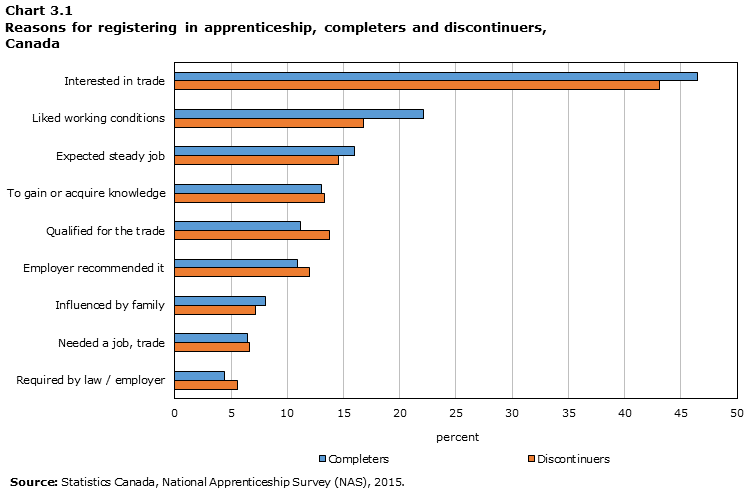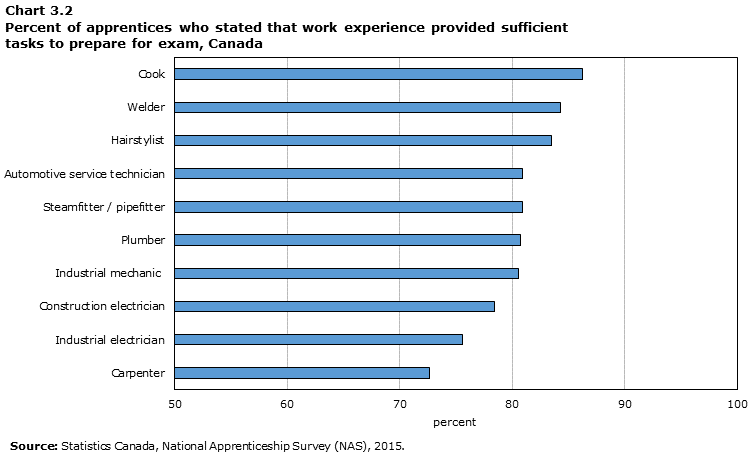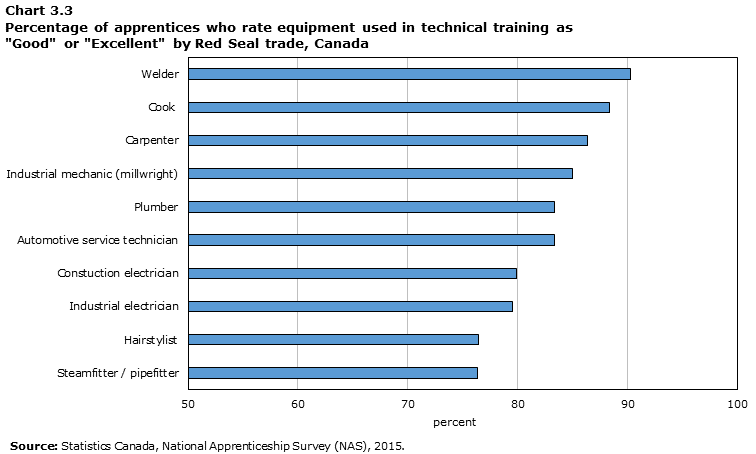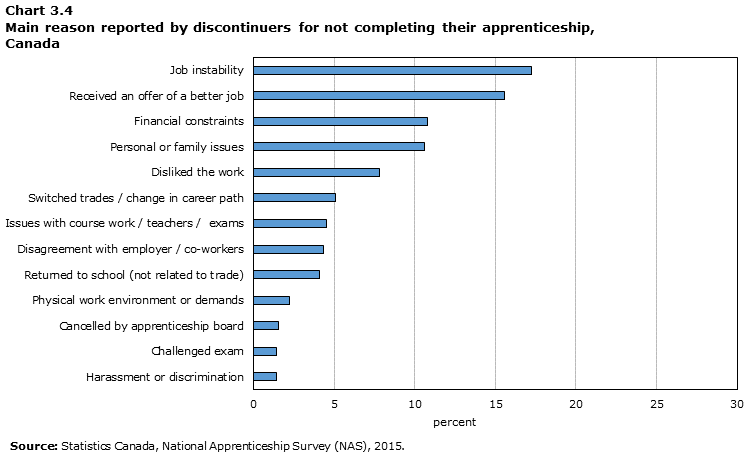National Apprenticeship Survey: Canada Overview Report 2015
Section 3 Experiences in apprenticeship program
Archived Content
Information identified as archived is provided for reference, research or recordkeeping purposes. It is not subject to the Government of Canada Web Standards and has not been altered or updated since it was archived. Please "contact us" to request a format other than those available.
One way to assess apprenticeship programs is to seek feedback from apprentices on their personal experiences. The 2015 NAS provides a wealth of information on apprentices’ experiences both before and during their apprenticeship programs. It also distinguishes between the experiences of apprentices who completed a program and those of apprentices who discontinued.
The first part of this section highlights apprentices’ awareness of and participation in pre-apprenticeship programs (programs in high school or work-related programs) as well as their reasons for becoming apprentices. This information serves to understand better the pathways individuals take in order to become apprentices.
The following part focuses on the experiences of completers and discontinuers during their programs. Some topics include:
- number of employers per program,
- nature of course work, whether they completed this work, and quality of technology used,
- level and types of difficulties they encountered (financial constraints and job instability),
- exam-readiness, and
- reasons for discontinuing a program.
Key findings
- More than 15% of apprentices (excluding QuebecNote 1), were registered in a youth apprenticeship program in high school.
- More than 2 in 5 (46.7%) apprentices, who did not participate in a youth apprenticeship program (outside Quebec), were involved in other trades-related or work experience programs during high school.
- The majority of apprentices reported that they had pursued apprenticeship programs because they were interested in the trade (45.0%) and because they liked the working conditions (19.8%).
- Apprentices cited family members as being influential in them learning a trade, with more completers (30.5%) reporting this than discontinuers (25.5%).
- The majority of apprentices (58.7%) had taken the required course work in the trade with the bulk of them following a long block-release schedule. Meanwhile, nearly 10% had completed an aspect of it online or by correspondence.
- Most apprentices (80.8%) did not have difficulty finding an employer for an apprenticeship program, although discontinuers reported more difficulty than completers.
- The most common challenges for completing a program were “financial constraints”, and “job instability,” with discontinuers citing the latter more than did completers.
- The majority of apprentices in the top 10 Red Seal trades reported that their programs had prepared them for their qualifying exams and that the equipment and technology were either good or excellent.
Pathways into trades
The 2015 NAS asked apprentices a number of questions about activities prior to an apprenticeship program. Some skilled trades appear to be later-entry careers, where youth are less inclined to enter apprenticeships directly out of high school. These data provide further insight into the awareness that apprentices had of skilled trades during their youth, as well as their involvement in any apprenticeship or trades-related programs in high school. Table A.3.1 (Appendix A) reports detailed results for the total NAS population as well as for completers and discontinuers separately.
Slightly more than 15% of apprentices (15.6%) outside Quebec were registered in a youth apprenticeship program (YAP) during high schoolNote 2 (Table A.3.1, Appendix A). Completers were less likely to have been registered in a YAP (12.7%) than discontinuers (19.2%). Of those apprentices who did not participate in a YAP, about half (51.7%) were aware of apprenticeship programs in the trades during secondary school. There was no significant difference between completers (49.0%) and discontinuers (47.2%) who did not participate in a YAP in terms of their awareness of apprenticeship programs during high school.
Among the 84.4% of apprentices outside Quebec who were not registered in a YAP during high school (non-YAP respondents), some indicated that they were involved in other trades-related or work experience programs. Results in Table A.3.1 (Appendix A) show that more than one quarter (27.1%) had participated in a trade, vocational, or technical program, while an additional 9.0% had experience with a co-op or work experience program during high school. Discontinuers were slightly more likely than completers to have taken a trade, vocational or technical program (28.6% and 26.1% respectively). About one in ten (10.6%) NAS apprentices were involved in both of these types of programs during a secondary school experience; discontinuers (11.8%) were slightly more likely than completers (9.8%) to have participated in both programs. More than half (53.3%) of non-YAP respondents did not participate in either type of program while in high school.
The 2015 NAS also asked apprentices about the reasons they had registered for an apprenticeship and who influenced their decisions to learn a trade. Table A.3.1 (Appendix A) presents these results. In the survey, apprentices could indicate more than one reason for entering an apprenticeship program. Chart 3.1, below, shows the distribution of all responses among apprentices.
The largest proportion of apprentices (45.0%) reported that an “interest in the trade” was the reason for registering in the apprenticeship (Table A.3.1, Appendix A). This was the most commonly cited reason among both completers (46.5%) and discontinuers (43.1%). Nearly one in five (19.8%) apprentices reported that they liked the working conditions, and 15.4% stated that the expectation of a steady job was the reason for registering in an apprenticeship. About 13% registered to gain or acquire knowledge of the trade. In comparison, employer-related reasons were less frequently reported. Eleven percent of apprentices stated that “an employer” recommended that they register for the program, while 4.9% were required by law (i.e., the trade is compulsory in a jurisdiction, and they must register as apprentices in order to work in it) or by an employer to do so (refer to Table A.3.1, Appendix A, for detailed results).

Data table for Chart 3.1
| Completers | Discontinuers | |
|---|---|---|
| percent | ||
| Required by law / employer | 5.6 | 4.4 |
| Needed a job, trade | 6.6 | 6.5 |
| Influenced by family | 7.2 | 8.1 |
| Employer recommended it | 11.9 | 10.9 |
| Qualified for the trade | 13.7 | 11.1 |
| To gain or acquire knowledge | 13.3 | 13.0 |
| Expected steady job | 14.6 | 16.0 |
| Liked working conditions | 16.8 | 22.1 |
| Interested in trade | 43.1 | 46.5 |
| Source: Statistics Canada, National Apprenticeship Survey (NAS), 2015. | ||
The individuals that apprentices cited as influencing their decisions to learn a trade are presented in Table A.3.1 (Appendix A). NAS apprentices could indicate more than one influence for this section. The highest proportion of apprentices identified family members as an influence on a decision to learn a trade. Close family members, i.e., “a parent / brother or sister / spouse or common-law partner”, were reported by 28.4% of apprentices; completers were more likely than discontinuers to report these family members as an influence (30.5% and 25.5%, respectively). Almost as many apprentices (21.4%) cited other “relatives or friends” as influential in the decision.
More than one in five (23.2%) apprentices reported that they had received no advice from others when deciding to learn a trade, while 9.2% indicated that “a co-worker or tradesperson / another apprentice / journeyperson” had influenced the decision. School officials, such as a teacher or principal (6.1%) or a high school guidance counsellor (2.6%), were among the least cited influences. Discontinuers were more likely than completers to report a school-related official as influential in the decision to learn a trade.
Experience during apprenticeship program
Apprentices were asked a range of questions about their experiences throughout their apprenticeships. In addition to general information about work experience (on-the-job training) and required course work (also called “technical training”), apprentices were asked whether they had encountered any challenges throughout a program and the nature of these difficulties. The detailed results can be found in Table A.3.2 and Table A.3.3 (Appendix A).
Overall, apprentices who had some work experience in a trade during an apprenticeship had on average 2.1 employers throughout a program (Table A.3.2, Appendix A). However, the majority (57.9%) reported having had only one employer during an apprenticeship. Discontinuers (62.9%) were more likely than completers (54.6%) to report that they had only one employer during an apprenticeship.
The majority of apprentices (58.7%) had taken the required course work related to a trade (Table A.3.2, Appendix A). Completers (69.6%) were much more likely than discontinuers (44.0%) to have taken the required course work. It is important to note that the number of hours of required course work and on-the-job training vary by trade and by jurisdiction.
Among completers and discontinuers who had taken required course work related to a trade, the majority took training by long block release (Table A.3.2, Appendix A). However, completers were more likely than discontinuers to have had this type of training schedule (63.6% and 49.5%, respectively). Seven percent of apprentices took technical training by short block release. About 1 in 5 apprentices did course work on a full-time schedule and discontinuers were more likely than completers to have been involved with this type of training. About 10% of apprentices had a self-paced course work schedule.
For most apprenticeship programs, technical training is typically delivered in a classroom; however, apprentices were also asked whether they took any of their required course work online or by correspondence. Of the total 2015 NAS population, fewer than 1 in 10 apprentices (9.7%) did course work online or by correspondence. Discontinuers (11.9%) were more likely than completers (8.7%) to have used these means for their course work (Table A.3.2, Appendix A).
Apprentices generally did not assess their work experiences and course work as difficult. Results reported in Table A.3.2 (Appendix A) show that the majority found that the on-the-job training component of the apprenticeship was easy (51.0% agreed; 13.2% strongly agreed) while about one third did not agree with this statement (31.0% disagreed; 4.8% strongly disagreed). Completers were slightly more likely than discontinuers to have disagreed with this statement (32.4% and 29.0%, respectively). A higher proportion of apprentices reported that they found their required course workNote 3 easy (60.2% agreed and 19.4% strongly agreed with this statement). About one in five apprentices reported that they did not find the course work easy (19.0% disagreed; 1.4% strongly disagreed).
Table A.3.3 (Appendix A) reports detailed results about the difficulties that apprentices encountered throughout an apprenticeship. Generally, most apprentices (80.8%) did not have any difficulty finding an employer who was hiring apprentices when they were starting an apprenticeship.Note 4 Discontinuers were more likely than completers to have reported difficulty finding an employer at this stage of an apprenticeship (23.3% and 16.2%, respectively).
Overall, nearly two thirds of apprentices (65.5%) reported experiencing no difficulty progressing through an apprenticeship program (Table A.3.3, Appendix A).Note 5 Of the 34.5% of apprentices who did report some difficulty, nearly one quarter (24.7%) reported “financial constraints” as the main challenge, and slightly fewer reported “job instability” (21.2%). About 12% of apprentices reported having “disagreed with [an] employer, co-workers or union” as the main difficulty encountered during an apprenticeship while fewer than 1 in 10 (7.9%) cited “personal or family issues.”
Apprentices who had discontinued their programs were more likely than completers to have experienced difficulty progressing through an apprenticeship (44.5% and 27.1%, respectively). Discontinuers were more likely than completers to have cited a “disagreement with [an] employer, co-workers or union”, “job instability”, or “personal or family issues” as the main difficulty they had encountered during a program. However, completers were more likely than discontinuers to have indicated “financial constraints,” “issues with course work / teachers / exams” and “transportation” as the main difficulty.
Assessment of work experience and technical training
Apprentices in the 2015 NAS were asked to assess aspects of the work experience and technical training (course work) components of their programs. With respect to their on-the-job training, apprentices were asked whether their work experiences provided a sufficient variety of tasks to prepare them well for the exam. About 80% of all apprentices reported that their work experiences had prepared them well for an exam associated with a trade (Table A.3.4, Appendix A). They were also asked to rate the technical training in terms of providing up-to-date equipment or technology; more than 80% rated the equipment or technology they used as either “excellent” (35.3%) or “good” (47.6%) (Table A.3.4, Appendix A).
Since the work experience and course work components of apprenticeships can vary across trades, Table A.3.4 (Appendix A) also reports the work experience and course work assessments of apprentices across the top 10 Red Seal trades. Chart 3.2 below shows the distribution of apprentices who reported that their work experiences provided a sufficient variety of tasks to prepare them well for the exam by Red Seal trade. In each of the top 10 Red Seal trades, more than 70% of apprentices reported that their work experiences had prepared them well for their trade exams. Cook apprentices were most likely to have agreed with this statement (86.3%) while carpenters were less likely (72.7%).

Data table for Chart 3.2
| Percent | |
|---|---|
| Carpenter | 72.7 |
| Industrial electrician | 75.5 |
| Construction electrician | 78.4 |
| Industrial mechanic | 80.6 |
| Plumber | 80.8 |
| Steamfitter / pipefitter | 80.9 |
| Automotive service technician | 81.0 |
| Hairstylist | 83.5 |
| Welder | 84.3 |
| Cook | 86.3 |
| Source: Statistics Canada, National Apprenticeship Survey (NAS), 2015. | |
Apprentices in the top 10 Red Seal trades also had mostly positive responses when rating the equipment and technology used in their technical training. These results are summarized in Chart 3.3 below (see Table A.3.4, Appendix A for detailed results). Across all ten trades at least three-quarters of apprentices reported that the equipment used was either “good” or “excellent.” Welder apprentices (90.3%) had the highest proportion who responded in this way while steamfitter / pipefitter (76.4%) and hairstylist (76.4%) apprentices had the lowest.

Data table for Chart 3.3
| Percent | |
|---|---|
| Steamfitter / pipefitter | 76.4 |
| Hairstylist | 76.5 |
| Industrial electrician | 79.5 |
| Constuction electrician | 79.9 |
| Automotive service technician | 83.4 |
| Plumber | 83.4 |
| Industrial mechanic (millwright) | 85.0 |
| Carpenter | 86.4 |
| Cook | 88.3 |
| Welder | 90.3 |
| Source: Statistics Canada, National Apprenticeship Survey (NAS), 2015. | |
Apprenticeship experiences of discontinuers
While the above sections presented results that pertained to both completers and discontinuers, the 2015 NAS asked discontinuers additional questions about their apprenticeship experiences. Apprentices who discontinued their apprenticeships between 2011 and 2013 reported how much of the program they had completed, as well as the reasons for not completing an apprenticeship. The detailed results for this section can be found in Table A.3.5 (Appendix A).
Of the discontinuers who had some work experience in the trade during their apprenticeships, 44.9% had completed the number of on-the-job hours required to write the trade exam. About one third (32.7%) of discontinuers, who had taken any course work required for the trade, had completed all of the required course work. A similar proportion (32.9%) had completed less than 50% of the required course work for a trade.
The main reason that discontinuers gave for not completing their apprenticeships are presented in Table A.3.5 (Appendix A) and Chart 3.4, below. The two most commonly cited reasons for discontinuing were “job instability” at 17.3% and “received a better job offer” at 15.5%. About 1 in 10 discontinuers also cited “financial constraints” (10.8%) or “personal or family issues” (10.6%) as the main reason for not completing their programs.

Data table for Chart 3.4
| Percent | |
|---|---|
| Harassment or discrimination | 1.4 |
| Challenged exam | 1.4 |
| Cancelled by apprenticeship board | 1.6 |
| Physical work environment or demands | 2.2 |
| Returned to school (not related to trade) | 4.1 |
| Disagreement with employer / co-workers | 4.4 |
| Issues with course work / teachers / exams | 4.6 |
| Switched trades / change in career path | 5.1 |
| Disliked the work | 7.8 |
| Personal or family issues | 10.6 |
| Financial constraints | 10.8 |
| Received an offer of a better job | 15.5 |
| Job instability | 17.3 |
| Source: Statistics Canada, National Apprenticeship Survey (NAS), 2015. | |
Notes
- Date modified:
